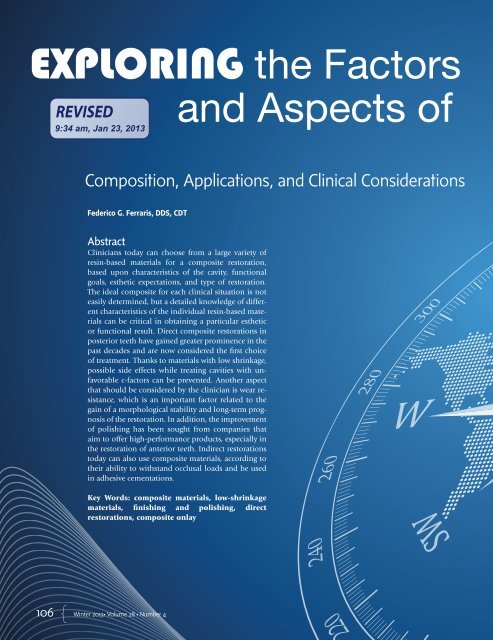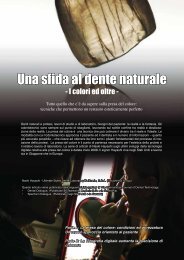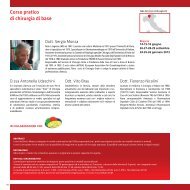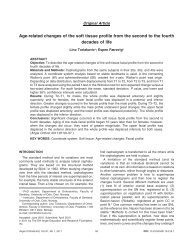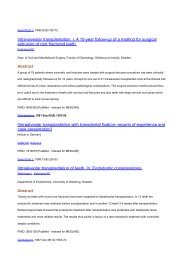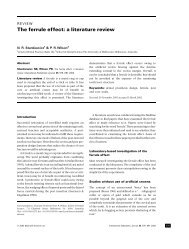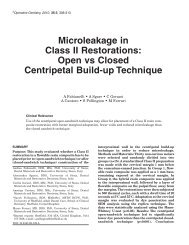Exploring the Factors and Aspects of Composit - OSTEOCOM
Exploring the Factors and Aspects of Composit - OSTEOCOM
Exploring the Factors and Aspects of Composit - OSTEOCOM
- No tags were found...
You also want an ePaper? Increase the reach of your titles
YUMPU automatically turns print PDFs into web optimized ePapers that Google loves.
Figure 1: Initial case involving Black Class IV cavity <strong>of</strong> #3 after fracture.IntroductionResin-Based MaterialsThe wide variety <strong>of</strong> composite materialsavailable today provides many opportunitiesbut can also cause confusion. Users<strong>of</strong> <strong>the</strong>se materials should be familiarwith <strong>the</strong>ir characteristics <strong>and</strong> distinctions.1-3According to classifications proposedby Ardu <strong>and</strong> colleagues, 4 resin-basedmaterials can be divided into conventional,hybrid, <strong>and</strong> micr<strong>of</strong>illed categories,depending upon <strong>the</strong> filler size <strong>and</strong>characteristics. Hybrid-defined compositematerials can be fur<strong>the</strong>r divided intocoarse, fine, <strong>and</strong> micro classifications,which can be additionally divided intohomogenous <strong>and</strong> inhomogeneous subclassifications.Additionally, <strong>the</strong>se materialscan be placed into four differentgroups, according to <strong>the</strong> matrix nature:• methacrylates• ormocers• compomers• silorane-based.MethacrylatesThe most well-known materials are <strong>the</strong>hybrid composites. This technology,based on methacrylates <strong>and</strong> differenttypes <strong>of</strong> filler coupled with silanes, hasbeen continuously improved. Somedisadvantages, such as volumetricshrinkage, bacterial adhesion, <strong>and</strong> sideeffects due to monomer release, stillremain, but <strong>the</strong> new technologies <strong>of</strong>ferimproved materials. To reduce <strong>the</strong>senegative factors, manufacturers haveworked on materials adapting <strong>the</strong> individualcomponents. The fillers are made<strong>of</strong> quartz, ceramic, silica, <strong>and</strong> o<strong>the</strong>r oxides.When filler content is increased,polymerization shrinkage, water absorption,<strong>and</strong> <strong>the</strong> linear expansion coefficientare reduced. Fur<strong>the</strong>rmore, compressive<strong>and</strong> tensile strength, modulus<strong>of</strong> elasticity, <strong>and</strong> wear resistance aregenerally increased. 5Nanohybrid composites are <strong>the</strong> newestfamily <strong>and</strong> probably <strong>the</strong> most widespreadon <strong>the</strong> market today. They aredesigned to provide superior es<strong>the</strong>tic<strong>and</strong> wear resistance as well as excellentpolishing <strong>and</strong> h<strong>and</strong>ling. Their agglomeratednanoclusters, interspersed withmicro-sized particles, give <strong>the</strong>m veryacceptable wear characteristics. Consequently,<strong>the</strong>y are considered “universal”materials suitable for anterior <strong>and</strong> posteriorteeth.These composites can have differenttypes <strong>of</strong> filler particles: prepolymerized,finely milled agglomerated nanoclusters;larger (submicron-sized) glass orsilica particles in <strong>the</strong> range <strong>of</strong> 0.4 m;<strong>and</strong> individual nano-sized particles(0.05m).This family <strong>of</strong> materials has manydesirable features regarding clinicalapplication, as will be explained. Examples<strong>of</strong> <strong>the</strong>se materials include <strong>the</strong>following:• Filtek Supreme XTE <strong>and</strong> Filtek Z250XT (3M ESPE; St. Paul, MN)• IPS Empress Direct <strong>and</strong> Tetric EvoCeram (Ivoclar Vivadent; Amherst,NY)• Enamel Plus HRi (Micerium;Avegno (GE), Italy)• Miris 2 <strong>and</strong> Synergy D6 (Coltène/Whaledent; Cuyahoga Falls, OH)• Venus Diamond <strong>and</strong> Venus Pearl(Heraeus Kulzer; South Bend, IN)• Herculite Ultra <strong>and</strong> Premise (Kerr;Orange, CA)• G-aenial <strong>and</strong> Kalore (GC America;Alsip, IL)• RefleXions XLS (Bisco; Schaumburg,IL)• Es<strong>the</strong>t-X HD (Dentsply Caulk; Milford,DE)• Estelite Sigma Quick (Tokuyama;Tokyo, Japan)• Gr<strong>and</strong>io (Voco America; BriarcliffManor, NY)• Clearfil Majesty (Kuraray; Houston,Tex).OrmocersWith organically modified ceramic materials(ormocers) (e.g., Admira, VocoAmerica), <strong>the</strong> methacrylate has beenpartially replaced by an inorganic network.According to some studies, <strong>the</strong>biocompatibility was not improved inall cases. 6,7CompomersCompomers aim to combine <strong>the</strong> positiveproperties <strong>of</strong> glass ionomers withcomposite technology (e.g., Dyract[Dentsply Caulk] <strong>and</strong> Compoglass [IvoclarVivadent). However, this goal hasonly partially succeeded, because <strong>the</strong>fluoride release is low. The fluoride release<strong>of</strong> compomers increases quicklyinitially (in <strong>the</strong> first 24 hours), but decreasesquickly, too. 8-11 Compomers aremost suitable for restorations in <strong>the</strong> deciduousdentition due to <strong>the</strong>ir low abrasionresistance. 12-14108 Winter 2013 • Volume 28 • Number 4
FerrarisAno<strong>the</strong>r important point to consider is <strong>the</strong> es<strong>the</strong>ticbehaviors <strong>of</strong> resin-based materials.Siloranes <strong>and</strong> Low-Shrinkage Resin-Based MaterialsManufacturers have addressed problemsrelated to shrinkage <strong>of</strong> resin-basedmaterials in different ways, includingincreasing molecular weight <strong>and</strong> developingmaterials with ring-shaped molecules.For example, silorane (siloxanes<strong>and</strong> oxirans) replaces <strong>the</strong> chain monomersin <strong>the</strong> composite matrix via ringshapedmolecules (e.g., Filtek SiloraneLS). These materials are hydrophobic<strong>and</strong> need to be bonded to <strong>the</strong> dentalhard tissue with a specific adhesive system.According to some studies, 15-17 silorane’slow shrinkage leads to a lowercontraction stress; fur<strong>the</strong>rmore, <strong>the</strong>serestorations were shown to have bothlow water absorption <strong>and</strong> water solubility.18 Silorane has also been shownto have good mechanical properties. 19,20The clinical application <strong>of</strong> <strong>the</strong>se materialsis limited to <strong>the</strong> posterior teeth,however, because few low-translucentcolors are available. 2Some research in <strong>the</strong> dental literaturedoes not support <strong>the</strong> use <strong>of</strong> siloranebasedmaterials. In one clinical study,<strong>the</strong> marginal quality <strong>of</strong> <strong>the</strong> siloranecomposite was shown to be somewhatinferior to that <strong>of</strong> a nanohybrid composite.21 In ano<strong>the</strong>r study, silorane didnot produce lower contraction stressthan o<strong>the</strong>r composites. 22As aforementioned, o<strong>the</strong>r monomerswith increased molecular weighthave been developed for compositeswith reduced shrinkage. Theurethane monomer TCD-DI-HEA(bis-(acryloyloxymethyl)tricyclo(5.2.1.02,6) decane), found in VenusDiamond <strong>and</strong> Venus Pearl, has beenshown to produce lower-curing contractionstress than o<strong>the</strong>r composites marketedas low-shrinking. 22 O<strong>the</strong>r lowshrinkagematerials are available, suchas <strong>the</strong> modified urethane dimethacrylate(UDMA) resin from DuPont foundin Kalore, which has a relatively highmolecular weight compared to bisphenola glycidyl methacrylate (bis-GMA)<strong>and</strong> traditional UDMA. Ano<strong>the</strong>r strategyis represented by dimer acid monomersused in N’Durance (Septodont;Lancaster, PA), which are also <strong>of</strong> relativelyhigh molecular weight <strong>and</strong> havebeen shown to have high conversion <strong>of</strong>carbon double bonds while undergoinglower polymerization shrinkage thanbis-GMA-based systems. 23,24Clinical ConsiderationsDirect AnteriorsIn anterior restorations, <strong>the</strong> materialmainly chosen, in many cases, is compositeresin. In <strong>the</strong> past, micro-particlecomposites were especially preferred for<strong>the</strong>ir good polishing, but <strong>the</strong>y showedlow resistance to surface wearing.Considering <strong>the</strong> fairly favorable c-factor in anterior areas (Black Class IIIor IV cavities 25 ) (Fig 1); <strong>and</strong> knowingthat addictive morphological modificationsmay need to be made, <strong>the</strong>reis no strong clinical indication to uselow-shrinkage materials. Therefore, it ismore appropriate to focus on differentmaterials.In anterior restorations, <strong>the</strong> goalis mechanical <strong>and</strong> wear strength. Fur<strong>the</strong>rmore,from an adequate polishedsurface, nanohybrids <strong>and</strong> nan<strong>of</strong>illedmaterials are recommended today. Invitro scientific studies have shown thatvarious nanohybrids materials yield anexcellent surface quality 26,27 <strong>and</strong> havelow wear, thanks to increased wear resistance.28-30 The nan<strong>of</strong>illed materialsalso possess preferred mechanical properties,31 a relatively low shrinkage rate,<strong>and</strong> high strength. 32 These types <strong>of</strong> materialsprovide excellent results concerningsurface roughness. 33 Additionally,some technologies have been fur<strong>the</strong>rdeveloped in this family <strong>of</strong> materials toimprove <strong>the</strong> maintenance <strong>of</strong> polishing,creating clusters with <strong>the</strong> nanoparticlesthat constitute <strong>the</strong> material (e.g., FiltekSupreme XTE).Ano<strong>the</strong>r important point to consideris <strong>the</strong> es<strong>the</strong>tic behaviors <strong>of</strong> resin-basedmaterials. Considering <strong>the</strong> translucency<strong>and</strong> opacity <strong>of</strong> both flowable <strong>and</strong> pastecomposites (generally photo-curable),it is advisable to choose <strong>the</strong> proper materialsto recreate <strong>the</strong> different areas <strong>of</strong>natural dentin <strong>and</strong> enamel. Some systems<strong>of</strong>fer many composite masses withintermediate translucency, which arevery similar to one ano<strong>the</strong>r, although<strong>the</strong>y are possibly deficient in translucencyeffects, intensives, <strong>and</strong> stains.The criteria <strong>of</strong> correct layering arealready well known. 34,35 Under normalconditions, <strong>the</strong> stratification <strong>of</strong> <strong>the</strong>composite provides in <strong>the</strong> most superficialarea an enamel that has goodtranslucency characteristics. This makesit possible to highlight <strong>the</strong> contrast between<strong>the</strong> dentin <strong>and</strong> <strong>the</strong> translucenteffects placed under it in a natural manner(Figs 2-5).Ano<strong>the</strong>r preferred feature, availablein some products currently on <strong>the</strong> market,is to have a composite light refractiveindex similar to natural tooth tissues.Generally, resin-based materialshave a lower refractive index; <strong>the</strong>refore,in equal thicknesses (composite <strong>and</strong>tooth), <strong>the</strong> optical behavior is different.Materials with a high refractive index(e.g., Enamel Plus HRi) provide an anatomicalstratification, with equal thicknessescompared to dental tissues.Lastly, in anterior composites a properfinishing is needed to emphasize <strong>the</strong>major <strong>and</strong> minor morphologies, includinga multiple-step polishing usingburs, polishers, discs, <strong>and</strong> brushes,which helps smooth out rough surfaces<strong>and</strong> achieve depth perception. It wasdemonstrated that <strong>the</strong> surface finishedusing multiple-step polishing systemsJournal <strong>of</strong> Cosmetic Dentistry109
Figure 2: After gentle preparation, <strong>the</strong> isolation <strong>of</strong> <strong>the</strong> field<strong>and</strong> phosphoric etching are performed.Figure 3: Adhesive procedures on hard tissues.Figure 4: Palatal enamel is layered onto <strong>the</strong> dentin prior toapplying effects <strong>and</strong> <strong>the</strong> final enamel covering.Figure 5: A layer <strong>of</strong> composite is applied using a specialsilicone tip.Figure 6: A medium-grit polisher is used during <strong>the</strong> finishingprocedure.Figure 7: A fine-grit polisher is used during <strong>the</strong> finishingstage.110 Winter 2013 • Volume 28 • Number 4
FerrarisFigure 8: An aluminium oxide disc is employed during <strong>the</strong>finishing stage.Figure 9: Diamond paste is applied with a brush during <strong>the</strong>polishing stage.Figure 10: Final results one week after completion <strong>of</strong> <strong>the</strong>restoration.Figure 11: Final results shown via a different photographictechnique that highlights certain morphologies.Figure 12: The initial case. Amalgam reconstructions on #6<strong>and</strong> #7 <strong>and</strong> a composite filling on #5 will be replaced.Figure 13: The old filling <strong>and</strong> secondary carious lesions areremoved, <strong>and</strong> <strong>the</strong> cavity is prepared.Journal <strong>of</strong> Cosmetic Dentistry111
was superior to that obtained with onestepsystems, 36 <strong>and</strong> three-step rubberpolishers were more efficient than twostep<strong>and</strong> one-step polishing methodson nanoparticle <strong>and</strong> hybrid resin composites(Figs 6-11). 37Flowable materials, which are usuallyless filled <strong>and</strong> less viscous comparedto paste composites, <strong>of</strong>ten suffer fromhigh shrinkage. These materials couldbest be used in Black Class I, II, or V cavities<strong>and</strong> in areas <strong>of</strong> cavitated enamel. 38Direct <strong>and</strong> Indirect PosteriorsAs a posterior restorative, resin compositerepresents <strong>the</strong> primary choicetoday for most clinicians. In in vivostudies analyzing <strong>the</strong> prognosis <strong>of</strong> compositerestorations, with 10 to 20 yearsfollow-up, <strong>the</strong> annual failure rate waslow: approximately 2%. 39-41 Gaengler<strong>and</strong> colleagues 39 described 10 years<strong>of</strong> follow-up <strong>of</strong> direct posterior compositewith <strong>the</strong> following conclusions:“The early risk <strong>of</strong> failure is attributed tobulk fractures <strong>and</strong> partial loss <strong>of</strong> fillingmaterial. The longevity over 10 yearsis a maximum <strong>of</strong> 74.2%, <strong>and</strong> <strong>the</strong> verylow secondary caries rate <strong>and</strong> <strong>the</strong> highpercentage <strong>of</strong> correct anatomical formconfirm <strong>the</strong> clinical safety <strong>of</strong> posteriorcomposite restorations.”In clinical studies that have compared<strong>the</strong> follow-up <strong>of</strong> posterior restorationswith amalgam <strong>and</strong> composite,<strong>the</strong> results are similar, although it canbe assumed that some amalgams have aslightly greater longevity. 42-44Ano<strong>the</strong>r study with 12 years <strong>of</strong>follow-up involving high caries-riskpatients compared composite <strong>and</strong>amalgam restorations. Both materialsshowed higher failure rates, although inlarge cavities composite behaved betterin patients with a lower caries risk. 45Posterior composite restorationscan be made via a direct or indirecttechnique. It has been shown that, ina medium-sized cavity, indirect <strong>and</strong>direct composite restorations have revealedno differences in performanceafter many years. 46 The cavity should beanalyzed carefully <strong>and</strong> a treatment evaluationshould be performed to determinewhich restoration is preferred, 47Figure 14: Etching phase during <strong>the</strong> adhesive procedure.Figure 15: The matrix has been positioned for <strong>the</strong> buildup <strong>of</strong> <strong>the</strong> interproximalwall. Some flowable composite was placed on <strong>the</strong> dentin to support <strong>the</strong>cervical residual enamel.Figure 16: The matrix from a buccal point <strong>of</strong> view, demonstrating <strong>the</strong>relationship between <strong>the</strong> wedge, matrix, <strong>and</strong> ring.112 Winter 2013 • Volume 28 • Number 4
FerrarisFigure 17: Completion <strong>of</strong> <strong>the</strong> layering <strong>of</strong> direct restorations.The composite buildup on #6 must now be finished.Figure 18: The cavity on #6 is prepared for <strong>the</strong> impression.Enamel margins are available on <strong>the</strong> full perimeter. Aretraction cord is positioned to <strong>the</strong> closest margins to <strong>the</strong>gingiva.Figure 19: <strong>Composit</strong>e onlay before cementation.Figure 20: Adhesive treatments <strong>of</strong> composite onlays:s<strong>and</strong>blasting (left), silane (middle), <strong>and</strong> bonding (right).Figure 21: Cavity cleaning under rubber dam,before <strong>the</strong> adhesive cementation.Figure 22: Cavity etching with phosphoricacid.Journal <strong>of</strong> Cosmetic Dentistry113
Figure 23: Cavity bonding.Figure 24: Excess cement must beremoved during onlay cementation <strong>of</strong><strong>the</strong> seating phase.Figure 25: Final results after one week showing a direct composite restoration on #5 <strong>and</strong> #7<strong>and</strong> an indirect onlay composite bonded on #6.<strong>and</strong> qualitative <strong>and</strong> quantitative evaluations<strong>of</strong> <strong>the</strong> residual cavity structures<strong>and</strong> <strong>the</strong> need to rebuild one or morecusps should be thoroughly considered.However, it is possible that teeth can bereconstructed within <strong>the</strong> same quadrantusing ei<strong>the</strong>r a direct or indirect technique(Figs 12-25).Direct posterior restorations aremore susceptible to shrinkage stresscompared to indirect restorations;hence, it may be desirable to use a materialwith low shrinkage <strong>and</strong> a favorableelasticity modulus. Fur<strong>the</strong>rmore,to minimize <strong>the</strong>se negative effects, itis recommended to use an appropriatelayering technique followed by propercuring for each layer.In Black Class II cavities, positioninga sectional matrix can help providea correct point <strong>of</strong> contact <strong>and</strong> resultin a good interproximal morphology(Figs 15 & 16).<strong>Composit</strong>e resins are also indicatedin indirect onlays (Figs 17 & 18). Somein vitro studies have compared indirectonlays with ceramic restorations <strong>and</strong>found that fracture resistance, when applyinga normal masticatory load, wassimilar for both materials. With masticatoryoverload, however, <strong>the</strong> compositegave better results in terms <strong>of</strong>resistance <strong>and</strong> distribution <strong>of</strong> stress on<strong>the</strong> root below. In addition, compositeresins layered <strong>and</strong> milled with CAD/CAM technology showed higher fatigueresistance than porcelain. 48,49 O<strong>the</strong>rdesirable features <strong>of</strong> composite resinsinclude better management <strong>of</strong> <strong>the</strong> morphology<strong>and</strong> less shrinkage <strong>of</strong> <strong>the</strong> material,which is polymerized out <strong>of</strong> <strong>the</strong>cavity (Fig 19).Indirect composite restorations canbe cemented adhesively, thanks to pretreatments<strong>and</strong> proper procedures. Unlikecemented porcelain restorations,indirect composite restorations ares<strong>and</strong>blasted (using aluminium oxideor silica coating) <strong>and</strong> not treated withhydr<strong>of</strong>luoric acid. 50,51 The pre-treatmentbefore <strong>the</strong> resin cement (that can belight-curable) can be represented bysilane <strong>and</strong> hydrophobic resinous bonding(Figs 20-25).114 Winter 2013 • Volume 28 • Number 4
27. Silikas N, Kavvadia K, Eliades G, Watts D. Surfacecharacterization <strong>of</strong> modern resin composites:a multi-technique approach. Am J Dent.2005;18(2):95-100.36. Watanabe T, Miyazaki M, Moore BK. Influence<strong>of</strong> polishing instruments on <strong>the</strong> surfacetexture <strong>of</strong> resin composites. Quintessence Int.2006;37(1):61-7.versus compomer/composite restorations inposterior primary <strong>and</strong> permanent teeth: findingsfrom <strong>the</strong> New Engl<strong>and</strong> Children’s AmalgamTrial. J Am Dent Assoc. 2007;138:763-72.28. Turssi CP, Ferracane JL, Serra MC. Abrasivewear <strong>of</strong> resin composites as related to finishing<strong>and</strong> polishing procedures. Dent Mater.2005;21(7):641-8.29. Yap AU, Tan CH, Chung SM. Wear behavior<strong>of</strong> new composite restoratives. Oper Dent.2004;29(3): 269-74.30. Xu HH, Quinn JB, Giuseppetti AA. Wear<strong>and</strong> mechanical properties <strong>of</strong> nano-silica-fusedwhisker composites. J Dent Res.2004;83(12):930-5.31. Mitra SB, Wu D, Holmes BN. An application <strong>of</strong>nanotechnology in advanced dental materials.J Am Dent Assoc. 2003;134(10):1382-90.32. Chen MH, Chen CR, Hsu SH, Sun SP, Su WF.Low shrinkage light curable nanocompositefor dental restorative material. Dent Mater.2006;22(2):138-45.33. Janus J, Fauxpoint G, Arntz Y, Pelletier H, EtienneO. Surface roughness <strong>and</strong> morphology<strong>of</strong> three nanocomposites after two differentpolishing treatments by a multitechnique approach.Dent Mater. 2010;26(5):416-25.34. Vanini L. Light <strong>and</strong> color in anterior compositerestorations. Pract Periodontics Aes<strong>the</strong>t Dent.1996 Sep;8(7):673-82; quiz 684.35. Dietschi D. Layering concepts in anteriorcomposite restorations. J Adhes Dent. 2001Spring;3(1):71-80.37. Jung M, Voit S, Klimek J. Surface geometry <strong>of</strong>three packable <strong>and</strong> one hybrid composite afterfinishing. Oper Dent. 2003;28(1):53-9.38. Yacizi AR, Ozgunaltay G, Dayangac B. The effect<strong>of</strong> different types <strong>of</strong> flowable restorativeresins on microleakage <strong>of</strong> Class V cavities.Oper Dent. 2003;28:773-8.39. Gaengler P, Hoyer I, Montag R. Clinical evaluation<strong>of</strong> posterior composite restorations: <strong>the</strong>10-year report. J Adhes Dent. 2001;3:185-94.40. Pallesen U, Qvist V. <strong>Composit</strong>e resin fillings<strong>and</strong> inlays. An 11-year evaluation. Clin OralInvest. 2003;7:71-9.41. DaRosa Rodolpho PA, Cenci MS, DonassolloTA, Loguércio AD, Demarco FF. A clinical evaluation<strong>of</strong> posterior composite restorations: 17-year findings. J Dent. 2006;34:427-35.42. Van Nieuwenhuysen JP, D’Hoore W, CarvalhoJ, Qvist V. Long-term evaluation <strong>of</strong> extensiverestorations in permanent teeth. J Dent.2003;31:395-405.43. Bernardo M, Luis H, Martin MD, Leroux BG,Rue T, Leitão J, DeRouen TA. Survival <strong>and</strong> reasonsfor failure <strong>of</strong> amalgam versus compositeposterior restorations placed in a r<strong>and</strong>omizedclinical trial. J Am Dent Assoc. 2007;138:775-83.44. Soncini JA, Maserejian NN, Trachtenberg F, TavaresM, Hayes C. The longevity <strong>of</strong> amalgam45. Opdam NJ, Bronkhorst EM, Loomans BA,Huysmans MC. Twelve-year survival <strong>of</strong> compositevs. amalgam restorations. J Dent Res.2010 Oct;89(10):1063-7. Epub July 26, 2010.46. Spreafico RC, Dietschi D, Kreijci I. Clinical performance<strong>and</strong> marginal adaption <strong>of</strong> Class II direct<strong>and</strong> semi-direct composite restorations. JDent. 2005 Jul;33(6):499-507.47. Fichera G, Devoto W, Re D. Cavity configurationsfor indirect partial coverage adhesivecementedrestorations. Hanover Park (IL):Quintessence Pub.; 2006:55-67.48. Magne P, Knezevic A. Simulated fatigue resistance<strong>of</strong> composite resin versus porcelainCAD/CAM overlay restorations on endodonticallytreated molars. Quintessence Int. 2009Feb;40(2):125-33.49. Magne P, Knezevic A. Influence <strong>of</strong> overlay restorativematerials <strong>and</strong> load cusps on <strong>the</strong> fatigueresistance <strong>of</strong> endodontically treated molars.Quintessence Int. 2009 Oct;40(9):729-37.50. Swift EJ Jr, Brodeur C, Cvitko E, Pires JA. Treatment<strong>of</strong> composite surfaces for indirect bonding.Dent Mater. 1992 May;8(3):193-6.51. Val<strong>and</strong>ro LF, Pelogia F, Galhano G, BottinoMA, Mallmann A. Surface conditioning <strong>of</strong> acomposite used for inlay/onlay restorations:effect on muTBS to resin cement. J Adhes Dent.2007 Dec;9(6):495-8. jCDDr. Ferraris is an active member <strong>of</strong> <strong>the</strong> European Academy <strong>of</strong> Es<strong>the</strong>tic Dentistry<strong>and</strong> <strong>of</strong> <strong>the</strong> Italian Academy <strong>of</strong> Conservative Dentistry. He is visiting pr<strong>of</strong>essor<strong>of</strong> es<strong>the</strong>tic dentistry at <strong>the</strong> University <strong>of</strong> San Pablo-CEU in Madrid, Spain. Dr.Ferraris lectures internationally <strong>and</strong> practices in Aless<strong>and</strong>ria, Italy.Disclosure: The author did not report any disclosures116 Winter 2013 • Volume 28 • Number 4
AdvertiserPage 117“Title”PremiumNewPick up


